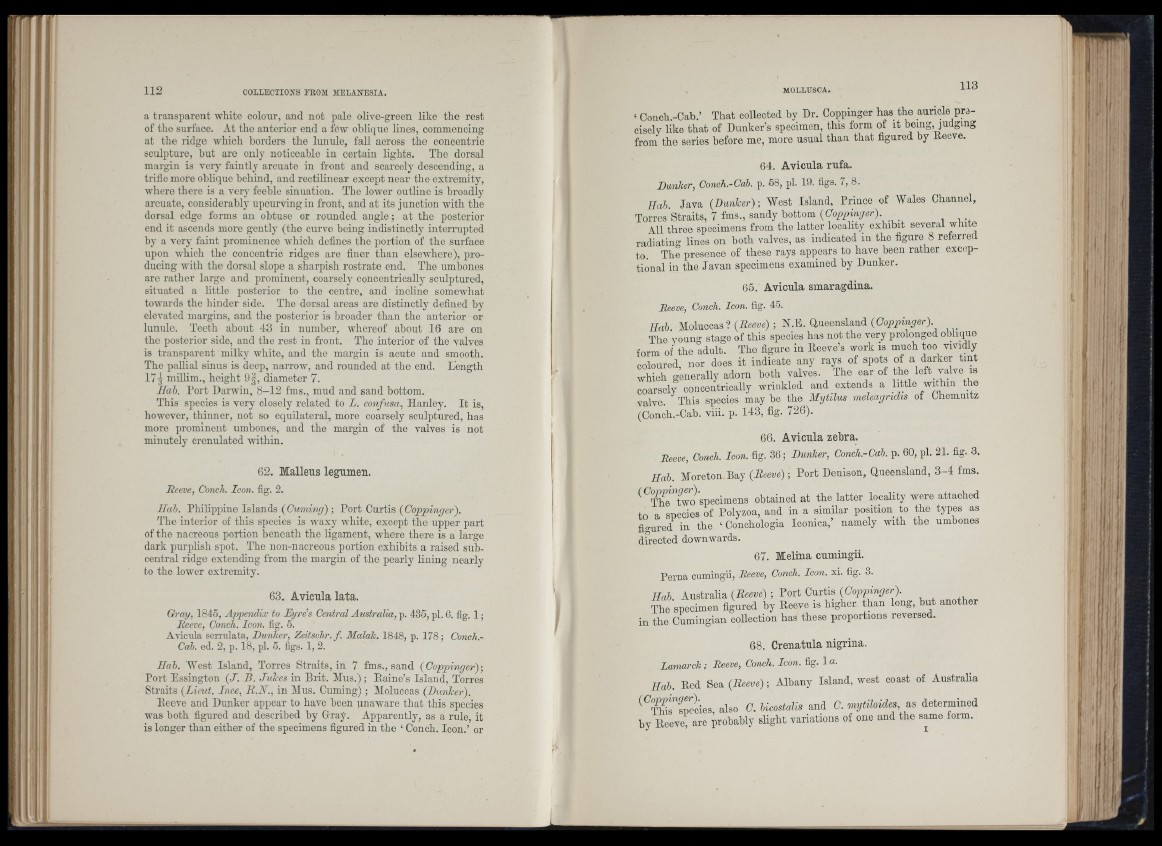
r r
a transparent white colour, and not pale olive-green like the rest
of the surface. At the anterior end a few oblique lines, commencing
at the ridge which borders the lunule, fall across the concentric
sculpture, hut are only noticeable iu certain lights. The dorsal
margin is very faintly arcuate in front and scarcely descending, a
trifle more oblique behind, and rectilinear except near tho extremity,
where there is a very feeble sinuation. The lower outline is broadly
arcuate, considerably upcurving in front, and at its junction with the
dorsal edge forms an obtuse or rounded angle; at the posterior
end it ascends more gently (the curve being indistinctly interrupted
by a very faint prominence which defines tho portion of the surface
upon which the concentric ridges are finer than elsew’hcre), producing
with the dorsal slope a sharpish rostrate end. The umbones
are rather large and prominent, coarsely concentrically sculptured,
situated a little posterior to the centre, and incline somewhat
towards the hinder side. The dorsal areas are distinctly defined by
elevated margins, and the posterior is broader than the anterior or
lunule. Teeth about 43 in number, whereof about 16 are on
the posterior side, and the rest in front. The interior of the valves
is transparent milky white, and the margin is acnto and smooth.
The pallial sinns is deep, narrow, and rounded at the end. Length
17g millim., height 9§, diameter 7.
Hab. Port Darwin, 8-12 fms., mud and sand bottom.
This species is very closely related to L. confusa, Hanley. I t is,
however, thinner, not so equilateral, more coarselj’’ sculptured, has
more prominent umbones, and the margin of the valves is not
minutely crenulated within.
62. Malleus legumen.
Eeeve, Conch. Icon. fig. 2.
Hah. Philippine Islands (Grmziz^); Fori Cartis, {Copqnnger).
The interior of this species is waxy white, except the upper part
of the nacreous portion beneath the ligament, where there is a large
dark purplish spot. The non-nacreous portion exhibits a raised sub-
central ridge extending from tho margin of the pearly lining nearly
to the lower extremity.
63. Avicula lata.
Gray, 1845, Appendix to Eyre’s Central Australia, p. 435, pi. 6. fi». 1;
Eeeve, Conch. Icon. fig. 5.
Avicula serrnlata, Bunker, Zeitschr. f . Malak. 1848, p. 178; Conch.-
Cah. ed. 2, p. 18, pi. 5. figs. 1, 2.
Hah. '^*est Island, Torres Straits, in 7 fms., sand {Coppinger);
Port Essington {J. B. Jukes in Brit. Mus.); Eaino’s Island, Torres
Straits {Lieut. Ince, B.N., in Mus. Cuming) ; Moluccas {Hunker).
Eeeve and Dunker appear to have been unaware th at this species
was both figured and described by Gray. Apparently, as a rule, it
is longer than either of the specimens figured in the ‘ Conch. Icon.’ or
1I
‘ Conch.-Cab.’ That collected by Dr. Coppinger has the auricle precisely
like th at of Dunker’s specimen, this form of it being, judging
from the series before me, more usual than th at figured by Eeeve.
64. Avicula rufa.
Hunker, Conch.-Cah. p. 58, pi. 19. figs. 7, 8.
Hah Java {Hunker); West Island, Prince of Wales Channel,
T o rre s S tr a its , 7 fm s ., sandy b o ttom (Go^i^Awf/er)
All three specimens from the latter locality exhibit several white
radiatin- lines on both valves, as indicated in the figure 8 referred
to The presence of these rays appears to have been rather exceptional
in the Javan specimens examined by Dunker.
65. Avicula smaragdina.
Reeve, Conch. Icon. fig. 45.
Hah M o l u c c a s ? (to«eiie); N.E. Queensland (Gopiimsrer)
The young stage of this species has not the very prolonged obhquo
form of the adult. The figure iu Eeeve’s work is much too vividly
coloured, nor does it indicate any rays of spots of a darker tint
which generally adorn both valves. The ear of the left valve is
coarsely concentrically wrinkled and extends a little within the
valve. This species may be the Mytilus meleagridis of Chemnitz
(Conch.-Cab. viii. p. 143, fig. 726).
66. Avicula zebra.
Beeve, Conch. Icon. fig. 36; Dunker, Conch.-Cah. p. 60, pi. 21. fig. 3.
Hah. Moreton Bay {Beeve); Port Denison, Queensland, 3 -4 fms.
^ two^ specimens obtained at the latter locality were attached
tn a snecies of Polyzoa, and in a similar position to the types as
figured in the ‘ Conchologia Iconica,’ namely with the umbones
dfrected downwards.
67. Melina cumingii.
Perna cumingii, Eeeve, Conch. Icon. xi. fig. 3.
Hah Australia {Eeeve) ; Port Curtis {Coppinger).
The specimen figured by Eeeve is higher than long, but another
the Cumingian collection has these proportions in reversed.
6 8 . C r e n a t u l a n i g r i n a .
Lamarck; Eeeve, Conch. Icon. fig. la .
Hah. Eed Sea {Beeve); Albany Island, west coast of Australia
also a I M d i , and C. as determined
t y llceye, are probably slight variaoons of one and the same form.
li I I
b i ' i